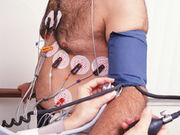Addition of exercise risk score to established risk model enhances discrimination
MONDAY, Nov. 9, 2015 (HealthDay News) — Exercise capacity (EC) and heart rate responses to exercise are effective predictors of short-term outcome among patients with stable coronary artery disease (CAD), according to a study published in the Nov. 15 issue of The American Journal of Cardiology.
Antti M. Kiviniemi, Ph.D., from University of Oulu in Finland, and colleagues evaluated exercise testing in 1,531 patients with angiographically documented stable CAD who were treated with β-blockers. Age- and gender-adjusted EC, maximal chronotropic response index (CRI), and two-minute post-exercise heart rate recovery (HRR) were calculated. The composite primary end point was cardiovascular deaths and hospitalization due to heart failure over a two-year follow-up. An exercise test risk score was also calculated.
The researchers found that, independent of each other, abnormal EC, CRI, and HRR predicted the primary end point, involving 4.5-, 2.2-, and 6.2-fold risk, respectively. Compared to patients with a low-risk exercise test score, patients with intermediate and high exercise test risk scores had 11.1-fold (P = 0.002) and 25.4-fold (P < 0.001) adjusted risk for the primary end point, respectively. The established risk model had enhanced discrimination by integrated discrimination index and reclassification by categorical and continuous net reclassification index (P < 0.001 for all) with the addition of the exercise risk score.
“The composite index of EC and heart rate responses to exercise and recovery is a powerful predictor of short-term outcome in patients with stable CAD,” the authors write.
Copyright © 2015 HealthDay. All rights reserved.








